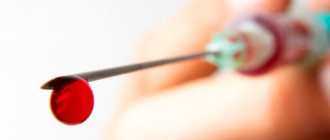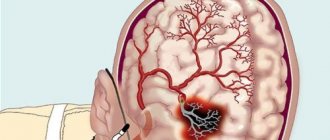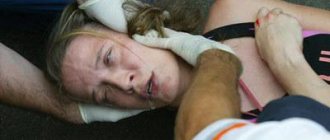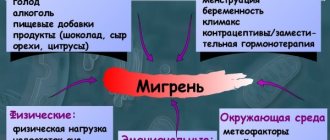Many people have experienced fainting, it occurs for a variety of reasons and can happen at any time. The main provoking factor is a problem with cerebral blood flow. Vasovagal syncope is the most common reason why people consult a doctor.
It is mainly encountered by people at a young age; the pathology occurs due to a sudden drop in blood pressure, as well as problems with the heart rhythm. You should know the features of this fainting so that you can take the right measures.
Features of the disease
This pathological condition is characterized by a temporary loss of consciousness, mainly when the person is in a standing position. It arises as follows: due to a rather low venous return, sympathetic tone begins to increase. In people who suffer from frequent fainting of this type, this increase can be quite large, which causes increased contraction of the heart. Intense impulses enter the brain from the nerves, which leads to increased parasympathetic and decreased sympathetic tone. As a result, bradycardia occurs, which lowers blood pressure, which is why fainting occurs.
What is this
Fainting is a sudden loss of consciousness, which is caused by a temporary disruption of blood flow . As a rule, a person recovers quickly, and all body functions return to normal. In some cases, patients suffer from fainting conditions. In such a situation, a person almost loses consciousness, but remains on his feet.
Directly with vasovagal syncope, vasodilation occurs, as well as a slowing of the heart rate. Because of this, a person loses consciousness, but then quickly comes to his senses.
The disease is not considered life-threatening, but it can significantly worsen its quality. Such phenomena are often encountered in childhood, and over the years the nature of the attacks can change.
Causes
Vasovagal syncope usually occurs due to an incorrect reaction of the body to irritation of specific receptors of the autonomic nervous system.
The most common causes of this disease are:
- strong emotions, such as fear;
- taking blood from a finger or vein, pain;
- standing for a long time;
- moderate physical activity with a sudden stop;
- wearing a tight tie or collar;
- fear of visiting the dentist.
Thus, if vasovagal syncope occurs, the reasons for this may vary. In any case, it is accompanied by a sharp dilation of blood vessels, a reduction in heart rate up to cardiac arrest, and a slowdown in breathing. Consciousness returns on its own within a few seconds.
People suffering from cardiovascular diseases are generally contraindicated from standing in the heat for a long time, as there is a high risk of fainting.
Therapeutic measures
The treatment regimen for vasovagal syncope is determined based on the severity of the underlying disease. Therapeutic intervention is mainly used for patients who often experience short-term loss of consciousness.
On this topic
- Fainting
The main causes of loss of consciousness with convulsions
- Editorial office of Neuralgia.ru
- March 26, 2020
In cases where the problem under consideration arises due to mental pathologies, the treatment regimen is determined depending on the status of the underlying disease.
Therapy for vasovagal syncope consists of several approaches.
Drug treatment
The patient is prescribed the following medications:
- Alpha adrenergic agonists. They contribute to the narrowing of blood vessels.
- Beta blockers. Such drugs block specific receptors in the body that are activated under the influence of stress hormones (adrenaline and norepinephrine).
- M-anticholinergics. Prescribed for the treatment of bradycardia.
Surgical intervention
Used in the presence of heart diseases and tumors. Surgical intervention, during which, if appropriate indications are available, a pacemaker is introduced, is carried out subject to the following conditions:
- age exceeds 40 years;
- vasovagal syncope occurs with regular frequency;
- absence of initial symptoms indicating imminent loss of consciousness;
- arrest was recorded .
Lifestyle change
You can prevent another loss of consciousness by following these recommendations:
- drink at least two liters of liquid per day;
- exclude heavy physical activity;
- avoid emotional stress;
- sleep at least eight hours a day;
- stop wearing tight underwear, replacing them with compression ones;
- regularly perform exercises aimed at strengthening your mental state.
Special isometric exercises are also used, through which you can increase blood pressure for a short period of time:
- Holding the ball in your hand, you need to squeeze your palm. The action promotes the outflow of venous blood.
- Hands clasp together and then forcefully pull in opposite directions.
- In a standing position, the legs are crossed, after which they must be tensed.
In case of sudden loss of consciousness, the person must be placed on his back with his legs raised above his head. This pose increases blood flow to the brain.
Vasovagal syncope is not dangerous to humans. It causes only two types of complications:
- injuries resulting from a fall;
- deterioration in quality of life in cases where fainting occurs frequently.
Preventive measures can help prevent another loss of consciousness.
Symptoms
Vasovagal syncope is accompanied by the following symptoms:
- immediately before loss of consciousness, sweating, nausea, darkening of the eyes, and tinnitus occur;
- the skin becomes pale;
- pulse and blood pressure are significantly reduced;
- fainting always occurs when a person is in an upright position, and if at the beginning of an attack you lay him horizontally, the illness will subside.
Diagnostics
You should consult a doctor immediately after the first attack occurs. Usually the causes of such fainting are not terrible, but sometimes it can indicate serious problems with the functioning of the body. For example, about tumors and cardiovascular diseases that can lead to death.
First, the doctor asks the patient when the fainting began, whether they occur in the same way, what precedes the loss of consciousness, and what the patient can attribute their occurrence to. After this, the doctor begins to be interested in the following questions:
- the patient’s profession and whether it is associated with a risk to life (driver, pilot, diver, roofer);
- whether the patient’s relatives suffer from cardiovascular diseases, whether they have experienced loss of consciousness, since vasovagal fainting can be hereditary.
Then the doctor examines the patient, notes his skin color, appearance of nails, hair, breathing rate, presence of heart murmurs and wheezing in the lungs. Prescribes general and biochemical blood tests.
In addition, diagnostics includes the following procedures:
- Electrocardiography (ECG), which determines the performance of the heart.
- 24-hour Holter electrocardiogram monitoring (HMECG). An electrocardiogram is recorded within 24-72 hours, and if fainting is detected, certain changes are displayed on it. Outside of fainting, normal values are noted.
- Echocardiography (EchoCG). It is carried out only to exclude vascular and heart diseases.
- Orthostatic test. Using this method, a diagnosis of “vasovagal syncope” is made. The essence of this procedure is that the patient lies down on a special bed at an angle of 60 degrees for 30 minutes. During this time, electrocardiogram readings are taken and blood pressure is measured automatically or manually. During fainting, there is a sharp drop in pressure and interruptions in the functioning of the heart.
Vasovagal fainting can also be isolated. They are not necessarily provoked by any disease; loss of consciousness often occurs in completely healthy people.
First aid for fainting
If the patient is feeling faint or has already lost consciousness, he should be placed on a horizontal surface, his clothes unbuttoned or removed - they restrict his breathing - and his legs should be placed on a hill to ensure blood flow to the head. In most cases, such help allows a person to quickly recover.
But it also happens that he continues to be in an unconscious state. In this case, it is necessary to give the brain some signal from the outside world so that it reacts and launches the entire “system”. This requires any strong stimulus. For example, you can give him ammonia to sniff, splash his face with cold water, or lightly pat his cheeks.
The patient should not be allowed to get up immediately after vasovagal syncope has occurred, since the blood supply has not yet been fully restored. It is necessary to bring him to his senses gradually, controlling his condition as far as possible. If such methods do not help, you should urgently call an ambulance, since prolonged brain hypoxia can cause irreversible changes, even death.
Vasovagal syncope - prevention and treatment
The most important thing in the case of vasovagal syncope is to prevent its occurrence. In addition, it is important that a person who is aware of the fact that they have symptoms of impending fainting tries to adopt a position that reduces the risk of fainting. It is worth sitting down, if possible, with your head tilted down, or lying down with your legs raised .
Of course, it is important to avoid situations in which fainting may occur. This includes, for example, stuffy rooms. Proper hydration of the body can also prevent a sudden drop in blood pressure.
When a person with a tendency to vasovagal fainting is forced to remain in “dangerous conditions” for a long time, he should move as often as possible, shift from foot to foot, and consciously stretch the muscles of the lower extremities. This improves the functioning of the muscle pump in the lower extremities and reduces the stagnation of venous blood in the legs.
Drug treatment
If vasovagal syncope is diagnosed, treatment depends on the severity of the illness. In some cases, loss of consciousness occurs very often, and it also happens that fainting goes away on its own. Treatment is usually prescribed for those whose condition occurs so frequently that the person becomes unable to work.
Drug therapy includes the use of beta-blockers such as Atenol and Metoprolol. With the help of these drugs, the processes of myocardial contraction are reduced and excessive activation of cardiac mechanoreceptors is prevented.
Bradycardia is treated with M-anticholinergic drugs. These are mainly patches consisting of scopolamine. They should be used once within three days. To reduce the frequency of fainting, the doctor prescribes Disopyramide, which has M-anticholinergic and negative inotropic effects. Theophylline is used much less frequently.
If during the diagnosis serious disturbances in the functioning of the heart, a lack of microelements or a tumor were identified, then the doctor should prescribe treatment methods in accordance with these diseases.
Fainting after exercise
There are situations where vasovagal syncope occurs after exercise. In this case, the provoking factors are: a tight collar, a sharp turn of the head, strong compression of the chest, pressure on the area of the carotid sinus.
Vasovagal syncope occurs in athletes in the following way:
- a sudden reflex expansion of peripheral vessels occurs, as a result of which cardiac output sharply decreases and cerebral hypoxia develops;
- There is a sudden reflex suppression of cardiac activity by the vagus nerve until the heart stops completely.
In the first case, ordinary fainting occurs, and in the second, blood circulation suddenly stops, which requires immediate medical attention.
Varieties
Statistics show that about 30% of adults have experienced syncope at least once. Fainting occurred in 4-6% of people who donated blood from a vein, and in 1% of patients receiving medical care in dental clinics. In medical practice, taking into account etiological factors, there are 3 main forms of fainting:
- Reflex (neurogenic) – diagnosed in 18% of cases.
- Cardiogenic. Occurs as a result of arrhythmia - 14% of cases, is associated with heart pathologies (valvular defects, cardiomyopathy, coronary disease) - 3% of cases.
- Occurring against the background of orthostatic hypotension – 8% of cases. A sudden change in body position, standing up or staying in an upright position for a long time is accompanied by insufficient blood flow to parts of the brain. The pathology is associated with a decrease in blood pressure.
Vasovagal syncope, along with situational (5% of cases), sinocarotid (1% of cases), atypical (34-48% of cases, etiological factors remain unknown) types belong to the reflex form. When describing vasovagal syncope, which is also known as simple or vasodepressor syncope, it is worth noting that it most often develops as a reaction of the body to stress. Situational syncope (fainting) can be triggered by the following factors:
- Sneezing and coughing.
- Eating and swallowing food.
- Physical exercise.
- Acts of urination and defecation.
- Abdominal pain.
These conditions are associated with a decrease in the volume of venous blood returning to the heart and increased activity of the vagus nerve. Syncope when coughing usually occurs in patients with diagnosed diseases of the respiratory system (acute pneumonia, chronic bronchitis).
The pathogenetic mechanism is associated with an increase in intrathoracic pressure, stimulation of vagal receptors (vagus nerve) located in the organs of the respiratory system, disruption of the pulmonary ventilation process, and a drop in oxygen saturation (blood saturation with oxygen).
Sinocarotid syncope usually occurs in older male patients. Provoking factors: rapid, sharp abduction of the head back, compression of the arteries supplying the brain in the neck due to a tightly tightened tie or a tightly buttoned shirt collar.
Syncope can be provoked by space-occupying formations (tumors, cysts) located in the area of the sinocarotid zone - the area where the carotid artery branches into external and internal branches. Activation of the carotid reflexes occurs due to the excitation of nerve endings located in the carotid sinus. As a result of compression of the carotid sinus, vasodilation occurs (relaxation, relaxation of the vascular wall) and a decrease in the number of heart contractions.
Preventive measures
If any serious disease has not been diagnosed, then you need to seriously think about taking preventive measures, which include the following:
- you need to avoid situations that can provoke loss of consciousness;
- You can’t stay in the heat for a long time, fast, smoke, drink alcohol, or overwork;
- it is necessary to limit strong physical activity for three months;
- you need to improve your health - do light jogging in the morning, swimming, water aerobics;
- contrast showers and hardening have a positive effect on blood vessels;
- In order for blood pressure to always be normal, it is necessary to follow a daily routine, i.e., find an optimal balance between work and rest, which will help save energy;
- Do not bend over sharply or get up from a lying position, as orthostatic collapse may occur;
- Drinking herbal tea from chamomile and mint, St. John's wort, and lemon balm normalizes blood pressure well.
Fainting during pregnancy
Vasovagal syncope sometimes occurs during pregnancy. The condition of a woman in an interesting position is often accompanied by general malaise and increased weakness, and this is associated with an increased load on the body. The appearance of fainting makes her very worried. They occur in the following cases:
- a sharp change in blood circulation;
- low blood sugar;
- sudden movements;
- heat and stuffiness;
- long and frequent lying on your back;
- toxicosis.
Frequent fainting is dangerous due to falling, so you should definitely inform your gynecologist about this.
Mechanism of vasovagal syncope
There are three main mechanisms of vasovagal syncope. The first mechanism involves a decrease in heart rate followed by a decrease in blood pressure. The second mechanism is closely related to the work of the heart. The pulse drops below 40 beats per minute or stops completely for 3 seconds . The last mechanism is a drop in pressure, but without a drop in heart rate.
Before it comes to vasovagal syncope, symptoms may appear in the form of: hearing loss, spots before the eyes, nausea, visual disturbances, dizziness, feeling hot, cold sweat, pale skin, feeling of a strong heartbeat, shortness of breath, weakness.










